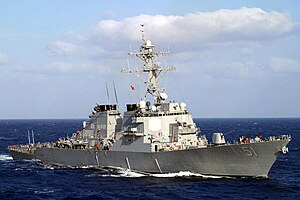USS Arleigh Burke (DDG-51)

USS Arleigh Burke (DDG-51) underway in the Mediterranean Sea in March 2003.
|
|
| History | |
|---|---|
|
|
|
| Name: | Arleigh Burke |
| Namesake: | Arleigh Albert Burke |
| Ordered: | 2 April 1985 |
| Builder: | Bath Iron Works |
| Laid down: | 6 December 1988 |
| Launched: | 16 September 1989 |
| Commissioned: | 4 July 1991 |
| Homeport: | NAVSTA Norfolk, Virginia, U.S. |
| Identification: | DDG-51 |
| Motto: | Fast and Feared |
| Status: | in active service |
| Badge: |  |
| General characteristics | |
| Class and type: | Arleigh Burke-class destroyer |
| Displacement: |
|
| Length: | 505 ft (154 m) |
| Beam: | 66 ft (20 m) |
| Draft: | 31 ft (9.4 m) |
| Propulsion: | 4 General Electric LM2500-30 gas turbines, two shafts, 100,000 total shaft horsepower (75 MW) |
| Speed: | >30 knots (56 km/h) |
| Range: |
|
| Complement: | |
| Sensors and processing systems: |
|
| Electronic warfare & decoys: |
|
| Armament: |
|
| Aircraft carried: | 2 Sikorsky MH-60R helicopters can be embarked |
USS Arleigh Burke (DDG-51), named for Admiral Arleigh A. Burke, USN (1901–1996), is the lead ship of the Arleigh Burke-class guided missile destroyers. She was laid down by the Bath Iron Works company at Bath, Maine, on 6 December 1988, and launched on 16 September 1989 by Mrs. Arleigh Burke. The Admiral was present in person at her commissioning ceremony on 4 July 1991, which was held on the waterfront in downtown Norfolk, Virginia.
Arleigh Burke's designers incorporated many lessons learned by the Royal Navy during the Falklands campaign and from the Ticonderoga-class guided-missile cruisers. The Ticonderoga-class cruisers were becoming too expensive to continue building, and were too difficult to upgrade.Arleigh Burke's design includes what is now better known as stealth technology, which improves the ship's ability to evade anti-ship missiles. She also uses a slightly downgraded version of the Aegis combat system, which allows for launching, tracking, and evading missiles simultaneously. Her all-steel construction provides good protection for her superstructure, while her Collective Protection System allows her to operate in environments contaminated by chemical, biological, or radiological materials.
Even before Arleigh Burke was commissioned, the Commander, Operational Test and Evaluation Force, was involved in the initial phases of testing. New systems, operated by fleet sailors ashore, were examined at land-based test facilities. The combat systems testing took place at the Combat System Engineering Development Site in Moorestown, New Jersey. The propulsion plant testing occurred at the Gas Turbine Ship Land-Based Engineering Site in Philadelphia, Pennsylvania. These test results supported the acquisition decision to begin limited production of the ship class.
...
Wikipedia
